RQFBM-ESBM0902051: Entrepreneurship & Small Business Management Report
VerifiedAdded on 2023/01/11
|22
|8146
|39
Report
AI Summary
This report provides a comprehensive overview of entrepreneurship and small business management, covering various types of entrepreneurial ventures and their relation to typology, including enterprises, entrepreneurs, intrapreneurs, owners, and managers. It differentiates between entrepreneurs and intrapreneurs, serial entrepreneurs, owner-managers, and examines micro, small, medium, and social enterprises. The report assesses the impact of micro and small businesses on the economy, describes the requirements for their growth, and elaborates on the characteristics and skills of successful entrepreneurs. Furthermore, it evaluates the influence of entrepreneurship personality traits on motivation and mindset, and identifies examples of entrepreneurs, analyzing how their backgrounds and experiences affect their goal achievement. The report concludes by emphasizing the importance of entrepreneurship in economic development and social welfare.
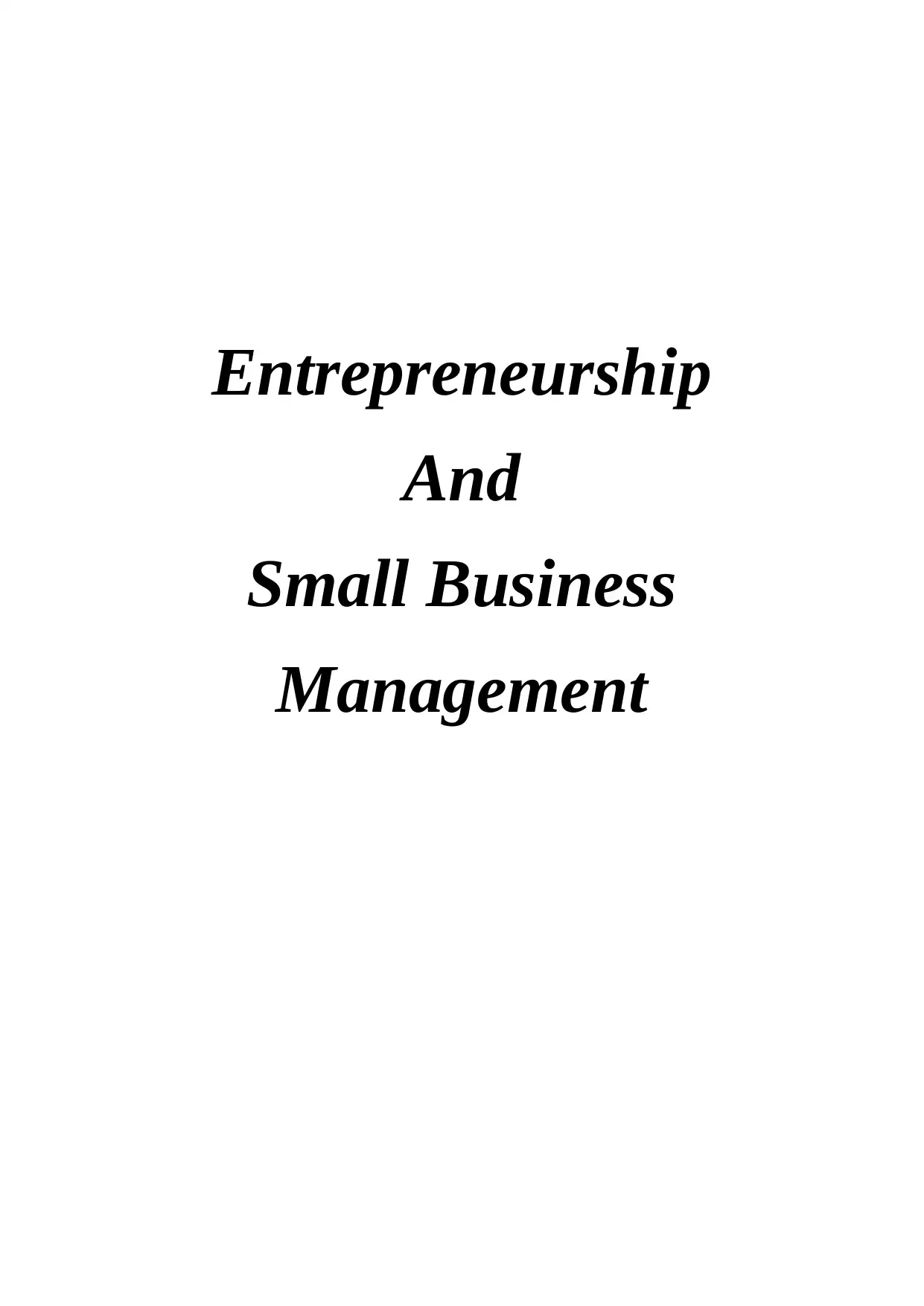
Entrepreneurship
And
Small Business
Management
And
Small Business
Management
Paraphrase This Document
Need a fresh take? Get an instant paraphrase of this document with our AI Paraphraser

Table of Contents
INTRODUCTION.....................................................................................................................................3
PART – A................................................................................................................................................3
TASK – 1.................................................................................................................................................3
P1. List various types of entrepreneurial ventures with its relation towards typology .....................3
P2. Explore the similarity and dissimilarity of commercial ventures..................................................7
M1. ....................................................................................................................................................9
D1. ..................................................................................................................................................10
TASK – 2...............................................................................................................................................10
P3. Assess relevant figures and statistics for illustrating micro and small business on economy....10
P4. Describe the essential requirement of small and scalable business for growth of social
economy..........................................................................................................................................11
M2. ..................................................................................................................................................11
D2. ..................................................................................................................................................12
PART – B..............................................................................................................................................12
TASK – 3...............................................................................................................................................12
P5. To elaborate the optimum characteristics, traits and skills of successful person that
differentiate from others.................................................................................................................12
P6. Evaluate the aspect of the entrepreneurship personality reflect the effective entrepreneur
motivation and mindset...................................................................................................................14
M3...................................................................................................................................................15
D3. ..................................................................................................................................................15
TASK – 4...............................................................................................................................................16
P7. Identify the examples of entrepreneurs for their background and experience which hinder and
foster in goal achievement..............................................................................................................16
M4. .................................................................................................................................................16
D4. ..................................................................................................................................................17
CONCLUSION.......................................................................................................................................17
REFERENCES.........................................................................................................................................18
INTRODUCTION.....................................................................................................................................3
PART – A................................................................................................................................................3
TASK – 1.................................................................................................................................................3
P1. List various types of entrepreneurial ventures with its relation towards typology .....................3
P2. Explore the similarity and dissimilarity of commercial ventures..................................................7
M1. ....................................................................................................................................................9
D1. ..................................................................................................................................................10
TASK – 2...............................................................................................................................................10
P3. Assess relevant figures and statistics for illustrating micro and small business on economy....10
P4. Describe the essential requirement of small and scalable business for growth of social
economy..........................................................................................................................................11
M2. ..................................................................................................................................................11
D2. ..................................................................................................................................................12
PART – B..............................................................................................................................................12
TASK – 3...............................................................................................................................................12
P5. To elaborate the optimum characteristics, traits and skills of successful person that
differentiate from others.................................................................................................................12
P6. Evaluate the aspect of the entrepreneurship personality reflect the effective entrepreneur
motivation and mindset...................................................................................................................14
M3...................................................................................................................................................15
D3. ..................................................................................................................................................15
TASK – 4...............................................................................................................................................16
P7. Identify the examples of entrepreneurs for their background and experience which hinder and
foster in goal achievement..............................................................................................................16
M4. .................................................................................................................................................16
D4. ..................................................................................................................................................17
CONCLUSION.......................................................................................................................................17
REFERENCES.........................................................................................................................................18
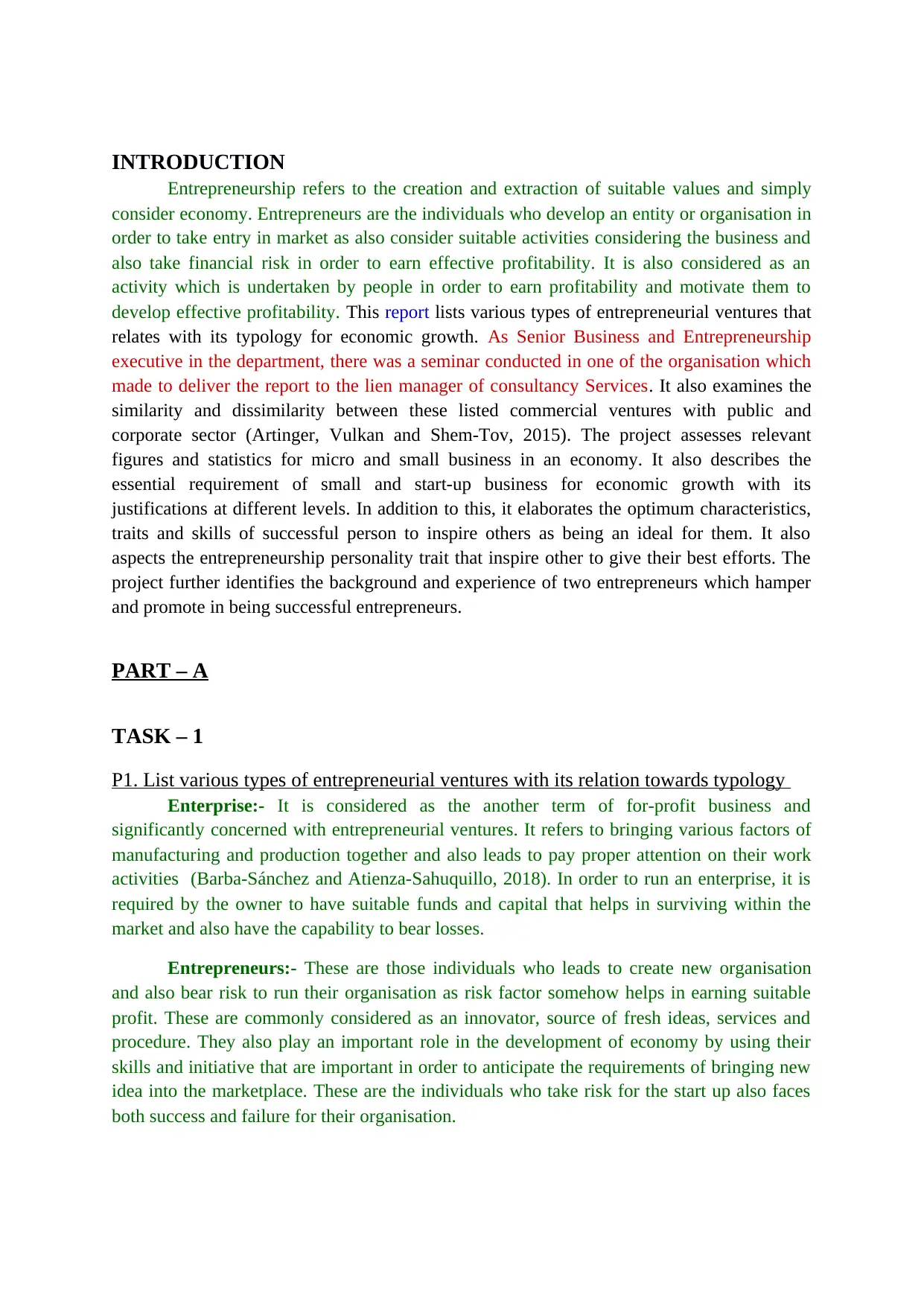
INTRODUCTION
Entrepreneurship refers to the creation and extraction of suitable values and simply
consider economy. Entrepreneurs are the individuals who develop an entity or organisation in
order to take entry in market as also consider suitable activities considering the business and
also take financial risk in order to earn effective profitability. It is also considered as an
activity which is undertaken by people in order to earn profitability and motivate them to
develop effective profitability. This report lists various types of entrepreneurial ventures that
relates with its typology for economic growth. As Senior Business and Entrepreneurship
executive in the department, there was a seminar conducted in one of the organisation which
made to deliver the report to the lien manager of consultancy Services. It also examines the
similarity and dissimilarity between these listed commercial ventures with public and
corporate sector (Artinger, Vulkan and Shem-Tov, 2015). The project assesses relevant
figures and statistics for micro and small business in an economy. It also describes the
essential requirement of small and start-up business for economic growth with its
justifications at different levels. In addition to this, it elaborates the optimum characteristics,
traits and skills of successful person to inspire others as being an ideal for them. It also
aspects the entrepreneurship personality trait that inspire other to give their best efforts. The
project further identifies the background and experience of two entrepreneurs which hamper
and promote in being successful entrepreneurs.
PART – A
TASK – 1
P1. List various types of entrepreneurial ventures with its relation towards typology
Enterprise:- It is considered as the another term of for-profit business and
significantly concerned with entrepreneurial ventures. It refers to bringing various factors of
manufacturing and production together and also leads to pay proper attention on their work
activities (Barba-Sánchez and Atienza-Sahuquillo, 2018). In order to run an enterprise, it is
required by the owner to have suitable funds and capital that helps in surviving within the
market and also have the capability to bear losses.
Entrepreneurs:- These are those individuals who leads to create new organisation
and also bear risk to run their organisation as risk factor somehow helps in earning suitable
profit. These are commonly considered as an innovator, source of fresh ideas, services and
procedure. They also play an important role in the development of economy by using their
skills and initiative that are important in order to anticipate the requirements of bringing new
idea into the marketplace. These are the individuals who take risk for the start up also faces
both success and failure for their organisation.
Entrepreneurship refers to the creation and extraction of suitable values and simply
consider economy. Entrepreneurs are the individuals who develop an entity or organisation in
order to take entry in market as also consider suitable activities considering the business and
also take financial risk in order to earn effective profitability. It is also considered as an
activity which is undertaken by people in order to earn profitability and motivate them to
develop effective profitability. This report lists various types of entrepreneurial ventures that
relates with its typology for economic growth. As Senior Business and Entrepreneurship
executive in the department, there was a seminar conducted in one of the organisation which
made to deliver the report to the lien manager of consultancy Services. It also examines the
similarity and dissimilarity between these listed commercial ventures with public and
corporate sector (Artinger, Vulkan and Shem-Tov, 2015). The project assesses relevant
figures and statistics for micro and small business in an economy. It also describes the
essential requirement of small and start-up business for economic growth with its
justifications at different levels. In addition to this, it elaborates the optimum characteristics,
traits and skills of successful person to inspire others as being an ideal for them. It also
aspects the entrepreneurship personality trait that inspire other to give their best efforts. The
project further identifies the background and experience of two entrepreneurs which hamper
and promote in being successful entrepreneurs.
PART – A
TASK – 1
P1. List various types of entrepreneurial ventures with its relation towards typology
Enterprise:- It is considered as the another term of for-profit business and
significantly concerned with entrepreneurial ventures. It refers to bringing various factors of
manufacturing and production together and also leads to pay proper attention on their work
activities (Barba-Sánchez and Atienza-Sahuquillo, 2018). In order to run an enterprise, it is
required by the owner to have suitable funds and capital that helps in surviving within the
market and also have the capability to bear losses.
Entrepreneurs:- These are those individuals who leads to create new organisation
and also bear risk to run their organisation as risk factor somehow helps in earning suitable
profit. These are commonly considered as an innovator, source of fresh ideas, services and
procedure. They also play an important role in the development of economy by using their
skills and initiative that are important in order to anticipate the requirements of bringing new
idea into the marketplace. These are the individuals who take risk for the start up also faces
both success and failure for their organisation.
⊘ This is a preview!⊘
Do you want full access?
Subscribe today to unlock all pages.

Trusted by 1+ million students worldwide
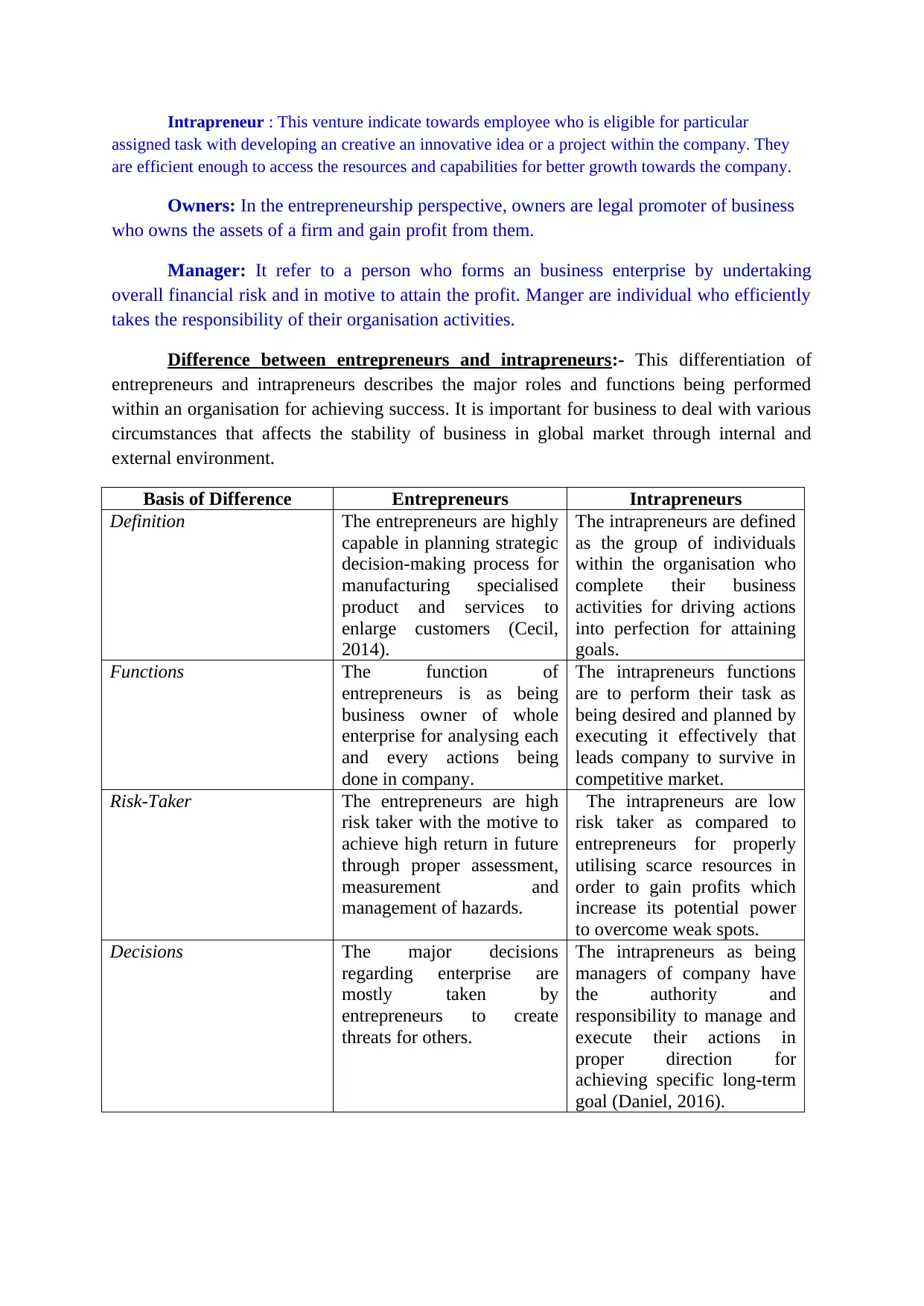
Intrapreneur : This venture indicate towards employee who is eligible for particular
assigned task with developing an creative an innovative idea or a project within the company. They
are efficient enough to access the resources and capabilities for better growth towards the company.
Owners: In the entrepreneurship perspective, owners are legal promoter of business
who owns the assets of a firm and gain profit from them.
Manager: It refer to a person who forms an business enterprise by undertaking
overall financial risk and in motive to attain the profit. Manger are individual who efficiently
takes the responsibility of their organisation activities.
Difference between entrepreneurs and intrapreneurs:- This differentiation of
entrepreneurs and intrapreneurs describes the major roles and functions being performed
within an organisation for achieving success. It is important for business to deal with various
circumstances that affects the stability of business in global market through internal and
external environment.
Basis of Difference Entrepreneurs Intrapreneurs
Definition The entrepreneurs are highly
capable in planning strategic
decision-making process for
manufacturing specialised
product and services to
enlarge customers (Cecil,
2014).
The intrapreneurs are defined
as the group of individuals
within the organisation who
complete their business
activities for driving actions
into perfection for attaining
goals.
Functions The function of
entrepreneurs is as being
business owner of whole
enterprise for analysing each
and every actions being
done in company.
The intrapreneurs functions
are to perform their task as
being desired and planned by
executing it effectively that
leads company to survive in
competitive market.
Risk-Taker The entrepreneurs are high
risk taker with the motive to
achieve high return in future
through proper assessment,
measurement and
management of hazards.
The intrapreneurs are low
risk taker as compared to
entrepreneurs for properly
utilising scarce resources in
order to gain profits which
increase its potential power
to overcome weak spots.
Decisions The major decisions
regarding enterprise are
mostly taken by
entrepreneurs to create
threats for others.
The intrapreneurs as being
managers of company have
the authority and
responsibility to manage and
execute their actions in
proper direction for
achieving specific long-term
goal (Daniel, 2016).
assigned task with developing an creative an innovative idea or a project within the company. They
are efficient enough to access the resources and capabilities for better growth towards the company.
Owners: In the entrepreneurship perspective, owners are legal promoter of business
who owns the assets of a firm and gain profit from them.
Manager: It refer to a person who forms an business enterprise by undertaking
overall financial risk and in motive to attain the profit. Manger are individual who efficiently
takes the responsibility of their organisation activities.
Difference between entrepreneurs and intrapreneurs:- This differentiation of
entrepreneurs and intrapreneurs describes the major roles and functions being performed
within an organisation for achieving success. It is important for business to deal with various
circumstances that affects the stability of business in global market through internal and
external environment.
Basis of Difference Entrepreneurs Intrapreneurs
Definition The entrepreneurs are highly
capable in planning strategic
decision-making process for
manufacturing specialised
product and services to
enlarge customers (Cecil,
2014).
The intrapreneurs are defined
as the group of individuals
within the organisation who
complete their business
activities for driving actions
into perfection for attaining
goals.
Functions The function of
entrepreneurs is as being
business owner of whole
enterprise for analysing each
and every actions being
done in company.
The intrapreneurs functions
are to perform their task as
being desired and planned by
executing it effectively that
leads company to survive in
competitive market.
Risk-Taker The entrepreneurs are high
risk taker with the motive to
achieve high return in future
through proper assessment,
measurement and
management of hazards.
The intrapreneurs are low
risk taker as compared to
entrepreneurs for properly
utilising scarce resources in
order to gain profits which
increase its potential power
to overcome weak spots.
Decisions The major decisions
regarding enterprise are
mostly taken by
entrepreneurs to create
threats for others.
The intrapreneurs as being
managers of company have
the authority and
responsibility to manage and
execute their actions in
proper direction for
achieving specific long-term
goal (Daniel, 2016).
Paraphrase This Document
Need a fresh take? Get an instant paraphrase of this document with our AI Paraphraser
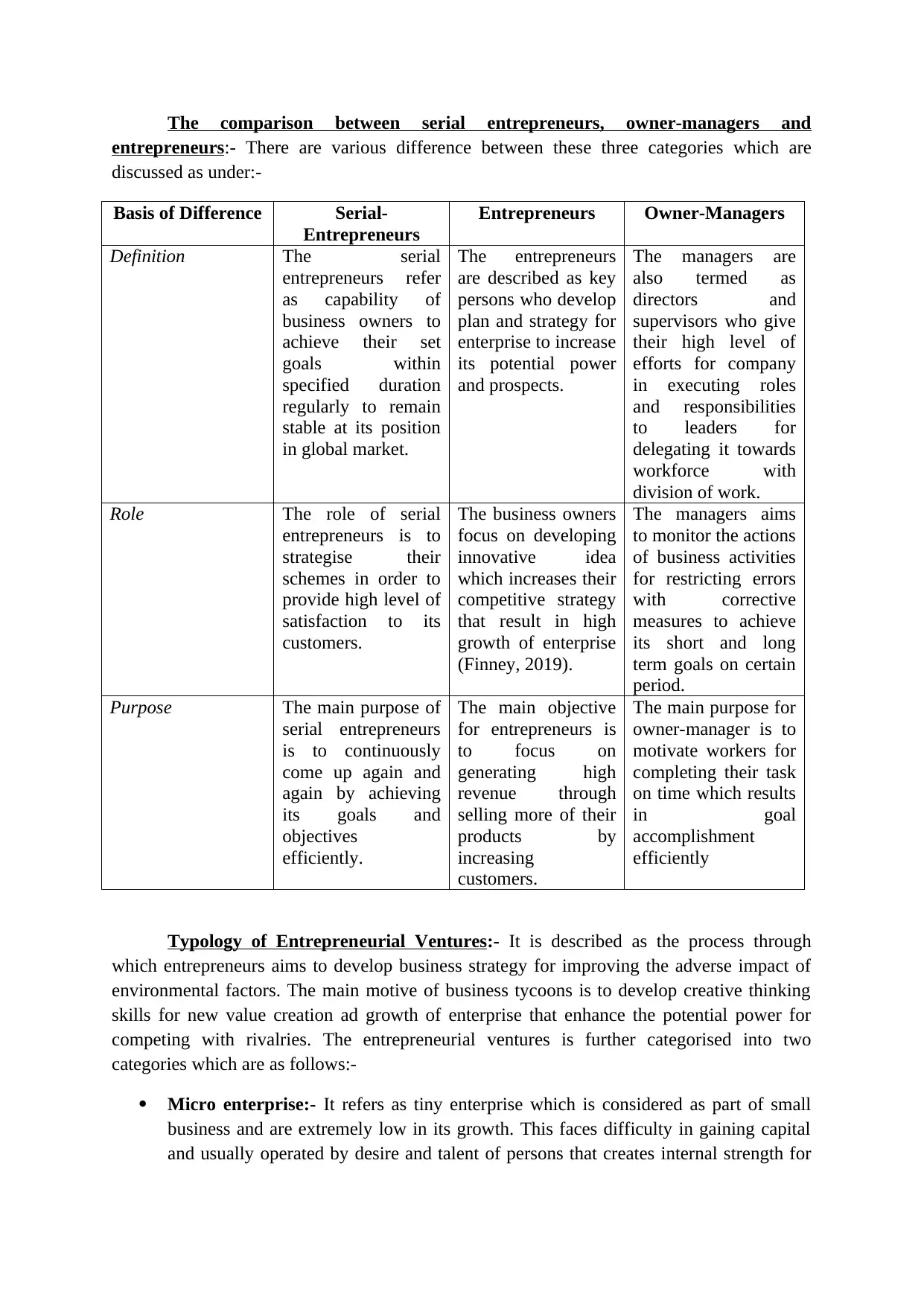
The comparison between serial entrepreneurs, owner-managers and
entrepreneurs:- There are various difference between these three categories which are
discussed as under:-
Basis of Difference Serial-
Entrepreneurs
Entrepreneurs Owner-Managers
Definition The serial
entrepreneurs refer
as capability of
business owners to
achieve their set
goals within
specified duration
regularly to remain
stable at its position
in global market.
The entrepreneurs
are described as key
persons who develop
plan and strategy for
enterprise to increase
its potential power
and prospects.
The managers are
also termed as
directors and
supervisors who give
their high level of
efforts for company
in executing roles
and responsibilities
to leaders for
delegating it towards
workforce with
division of work.
Role The role of serial
entrepreneurs is to
strategise their
schemes in order to
provide high level of
satisfaction to its
customers.
The business owners
focus on developing
innovative idea
which increases their
competitive strategy
that result in high
growth of enterprise
(Finney, 2019).
The managers aims
to monitor the actions
of business activities
for restricting errors
with corrective
measures to achieve
its short and long
term goals on certain
period.
Purpose The main purpose of
serial entrepreneurs
is to continuously
come up again and
again by achieving
its goals and
objectives
efficiently.
The main objective
for entrepreneurs is
to focus on
generating high
revenue through
selling more of their
products by
increasing
customers.
The main purpose for
owner-manager is to
motivate workers for
completing their task
on time which results
in goal
accomplishment
efficiently
Typology of Entrepreneurial Ventures:- It is described as the process through
which entrepreneurs aims to develop business strategy for improving the adverse impact of
environmental factors. The main motive of business tycoons is to develop creative thinking
skills for new value creation ad growth of enterprise that enhance the potential power for
competing with rivalries. The entrepreneurial ventures is further categorised into two
categories which are as follows:-
Micro enterprise:- It refers as tiny enterprise which is considered as part of small
business and are extremely low in its growth. This faces difficulty in gaining capital
and usually operated by desire and talent of persons that creates internal strength for
entrepreneurs:- There are various difference between these three categories which are
discussed as under:-
Basis of Difference Serial-
Entrepreneurs
Entrepreneurs Owner-Managers
Definition The serial
entrepreneurs refer
as capability of
business owners to
achieve their set
goals within
specified duration
regularly to remain
stable at its position
in global market.
The entrepreneurs
are described as key
persons who develop
plan and strategy for
enterprise to increase
its potential power
and prospects.
The managers are
also termed as
directors and
supervisors who give
their high level of
efforts for company
in executing roles
and responsibilities
to leaders for
delegating it towards
workforce with
division of work.
Role The role of serial
entrepreneurs is to
strategise their
schemes in order to
provide high level of
satisfaction to its
customers.
The business owners
focus on developing
innovative idea
which increases their
competitive strategy
that result in high
growth of enterprise
(Finney, 2019).
The managers aims
to monitor the actions
of business activities
for restricting errors
with corrective
measures to achieve
its short and long
term goals on certain
period.
Purpose The main purpose of
serial entrepreneurs
is to continuously
come up again and
again by achieving
its goals and
objectives
efficiently.
The main objective
for entrepreneurs is
to focus on
generating high
revenue through
selling more of their
products by
increasing
customers.
The main purpose for
owner-manager is to
motivate workers for
completing their task
on time which results
in goal
accomplishment
efficiently
Typology of Entrepreneurial Ventures:- It is described as the process through
which entrepreneurs aims to develop business strategy for improving the adverse impact of
environmental factors. The main motive of business tycoons is to develop creative thinking
skills for new value creation ad growth of enterprise that enhance the potential power for
competing with rivalries. The entrepreneurial ventures is further categorised into two
categories which are as follows:-
Micro enterprise:- It refers as tiny enterprise which is considered as part of small
business and are extremely low in its growth. This faces difficulty in gaining capital
and usually operated by desire and talent of persons that creates internal strength for
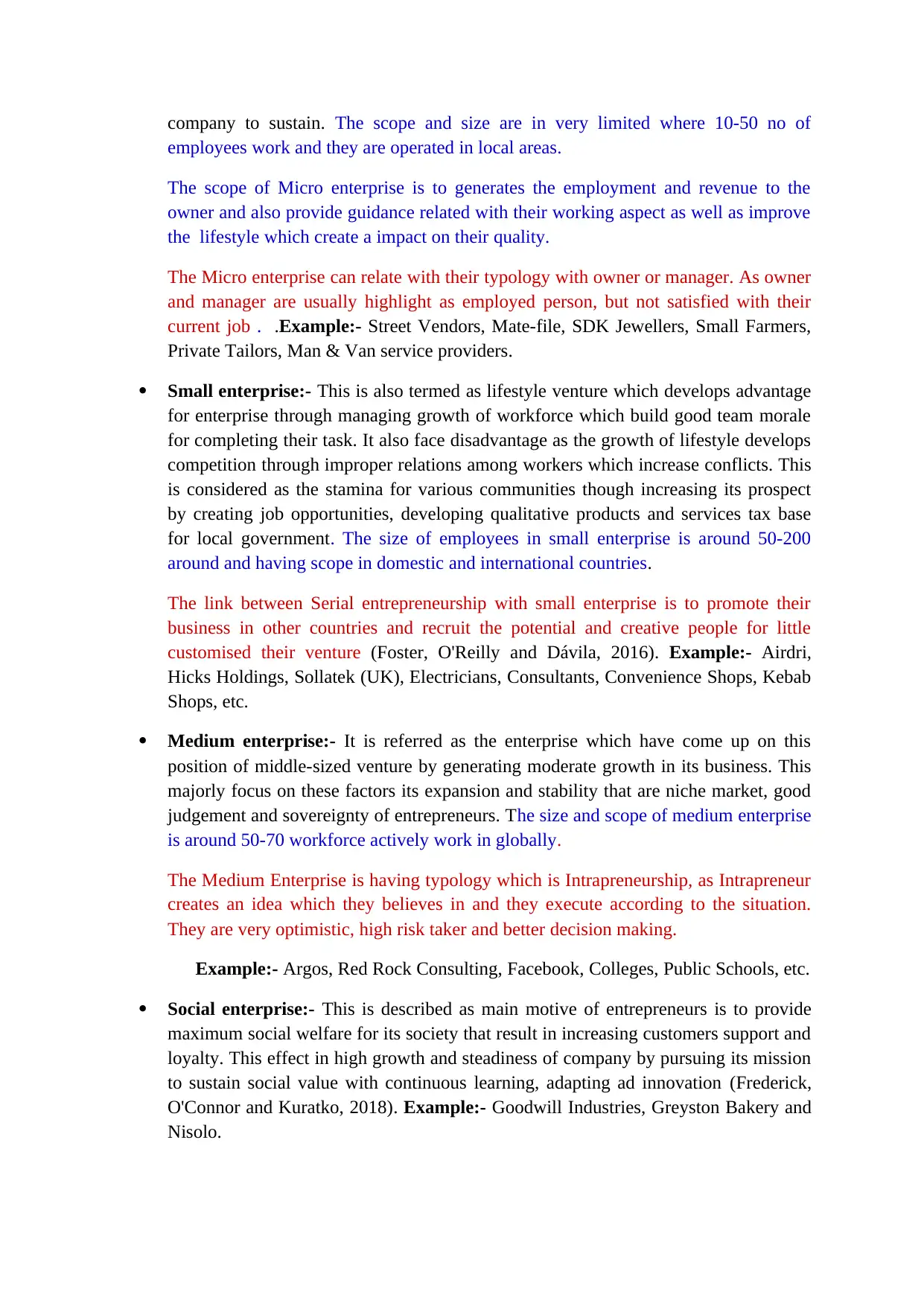
company to sustain. The scope and size are in very limited where 10-50 no of
employees work and they are operated in local areas.
The scope of Micro enterprise is to generates the employment and revenue to the
owner and also provide guidance related with their working aspect as well as improve
the lifestyle which create a impact on their quality.
The Micro enterprise can relate with their typology with owner or manager. As owner
and manager are usually highlight as employed person, but not satisfied with their
current job . .Example:- Street Vendors, Mate-file, SDK Jewellers, Small Farmers,
Private Tailors, Man & Van service providers.
Small enterprise:- This is also termed as lifestyle venture which develops advantage
for enterprise through managing growth of workforce which build good team morale
for completing their task. It also face disadvantage as the growth of lifestyle develops
competition through improper relations among workers which increase conflicts. This
is considered as the stamina for various communities though increasing its prospect
by creating job opportunities, developing qualitative products and services tax base
for local government. The size of employees in small enterprise is around 50-200
around and having scope in domestic and international countries.
The link between Serial entrepreneurship with small enterprise is to promote their
business in other countries and recruit the potential and creative people for little
customised their venture (Foster, O'Reilly and Dávila, 2016). Example:- Airdri,
Hicks Holdings, Sollatek (UK), Electricians, Consultants, Convenience Shops, Kebab
Shops, etc.
Medium enterprise:- It is referred as the enterprise which have come up on this
position of middle-sized venture by generating moderate growth in its business. This
majorly focus on these factors its expansion and stability that are niche market, good
judgement and sovereignty of entrepreneurs. The size and scope of medium enterprise
is around 50-70 workforce actively work in globally.
The Medium Enterprise is having typology which is Intrapreneurship, as Intrapreneur
creates an idea which they believes in and they execute according to the situation.
They are very optimistic, high risk taker and better decision making.
Example:- Argos, Red Rock Consulting, Facebook, Colleges, Public Schools, etc.
Social enterprise:- This is described as main motive of entrepreneurs is to provide
maximum social welfare for its society that result in increasing customers support and
loyalty. This effect in high growth and steadiness of company by pursuing its mission
to sustain social value with continuous learning, adapting ad innovation (Frederick,
O'Connor and Kuratko, 2018). Example:- Goodwill Industries, Greyston Bakery and
Nisolo.
employees work and they are operated in local areas.
The scope of Micro enterprise is to generates the employment and revenue to the
owner and also provide guidance related with their working aspect as well as improve
the lifestyle which create a impact on their quality.
The Micro enterprise can relate with their typology with owner or manager. As owner
and manager are usually highlight as employed person, but not satisfied with their
current job . .Example:- Street Vendors, Mate-file, SDK Jewellers, Small Farmers,
Private Tailors, Man & Van service providers.
Small enterprise:- This is also termed as lifestyle venture which develops advantage
for enterprise through managing growth of workforce which build good team morale
for completing their task. It also face disadvantage as the growth of lifestyle develops
competition through improper relations among workers which increase conflicts. This
is considered as the stamina for various communities though increasing its prospect
by creating job opportunities, developing qualitative products and services tax base
for local government. The size of employees in small enterprise is around 50-200
around and having scope in domestic and international countries.
The link between Serial entrepreneurship with small enterprise is to promote their
business in other countries and recruit the potential and creative people for little
customised their venture (Foster, O'Reilly and Dávila, 2016). Example:- Airdri,
Hicks Holdings, Sollatek (UK), Electricians, Consultants, Convenience Shops, Kebab
Shops, etc.
Medium enterprise:- It is referred as the enterprise which have come up on this
position of middle-sized venture by generating moderate growth in its business. This
majorly focus on these factors its expansion and stability that are niche market, good
judgement and sovereignty of entrepreneurs. The size and scope of medium enterprise
is around 50-70 workforce actively work in globally.
The Medium Enterprise is having typology which is Intrapreneurship, as Intrapreneur
creates an idea which they believes in and they execute according to the situation.
They are very optimistic, high risk taker and better decision making.
Example:- Argos, Red Rock Consulting, Facebook, Colleges, Public Schools, etc.
Social enterprise:- This is described as main motive of entrepreneurs is to provide
maximum social welfare for its society that result in increasing customers support and
loyalty. This effect in high growth and steadiness of company by pursuing its mission
to sustain social value with continuous learning, adapting ad innovation (Frederick,
O'Connor and Kuratko, 2018). Example:- Goodwill Industries, Greyston Bakery and
Nisolo.
⊘ This is a preview!⊘
Do you want full access?
Subscribe today to unlock all pages.

Trusted by 1+ million students worldwide
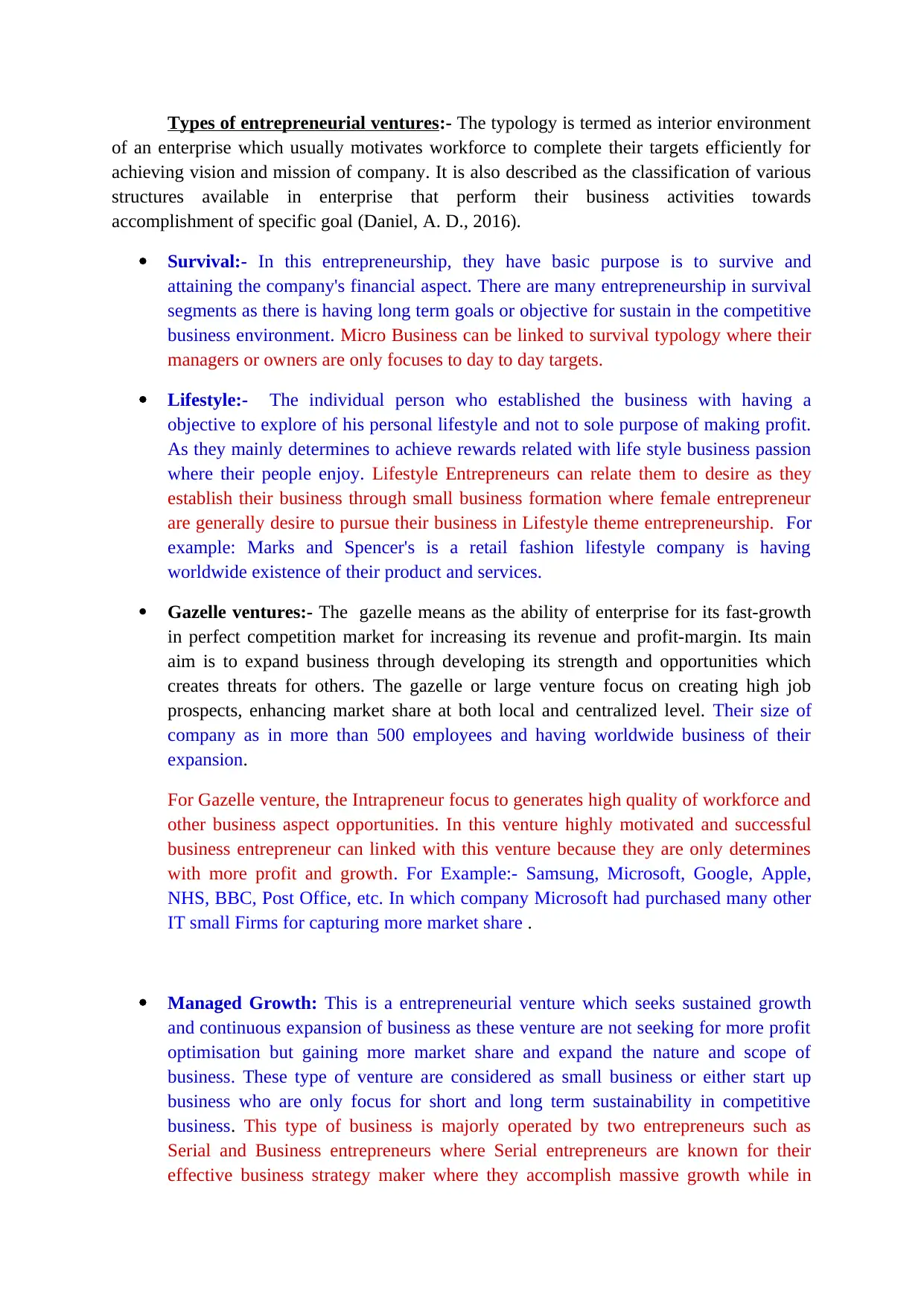
Types of entrepreneurial ventures:- The typology is termed as interior environment
of an enterprise which usually motivates workforce to complete their targets efficiently for
achieving vision and mission of company. It is also described as the classification of various
structures available in enterprise that perform their business activities towards
accomplishment of specific goal (Daniel, A. D., 2016).
Survival:- In this entrepreneurship, they have basic purpose is to survive and
attaining the company's financial aspect. There are many entrepreneurship in survival
segments as there is having long term goals or objective for sustain in the competitive
business environment. Micro Business can be linked to survival typology where their
managers or owners are only focuses to day to day targets.
Lifestyle:- The individual person who established the business with having a
objective to explore of his personal lifestyle and not to sole purpose of making profit.
As they mainly determines to achieve rewards related with life style business passion
where their people enjoy. Lifestyle Entrepreneurs can relate them to desire as they
establish their business through small business formation where female entrepreneur
are generally desire to pursue their business in Lifestyle theme entrepreneurship. For
example: Marks and Spencer's is a retail fashion lifestyle company is having
worldwide existence of their product and services.
Gazelle ventures:- The gazelle means as the ability of enterprise for its fast-growth
in perfect competition market for increasing its revenue and profit-margin. Its main
aim is to expand business through developing its strength and opportunities which
creates threats for others. The gazelle or large venture focus on creating high job
prospects, enhancing market share at both local and centralized level. Their size of
company as in more than 500 employees and having worldwide business of their
expansion.
For Gazelle venture, the Intrapreneur focus to generates high quality of workforce and
other business aspect opportunities. In this venture highly motivated and successful
business entrepreneur can linked with this venture because they are only determines
with more profit and growth. For Example:- Samsung, Microsoft, Google, Apple,
NHS, BBC, Post Office, etc. In which company Microsoft had purchased many other
IT small Firms for capturing more market share .
Managed Growth: This is a entrepreneurial venture which seeks sustained growth
and continuous expansion of business as these venture are not seeking for more profit
optimisation but gaining more market share and expand the nature and scope of
business. These type of venture are considered as small business or either start up
business who are only focus for short and long term sustainability in competitive
business. This type of business is majorly operated by two entrepreneurs such as
Serial and Business entrepreneurs where Serial entrepreneurs are known for their
effective business strategy maker where they accomplish massive growth while in
of an enterprise which usually motivates workforce to complete their targets efficiently for
achieving vision and mission of company. It is also described as the classification of various
structures available in enterprise that perform their business activities towards
accomplishment of specific goal (Daniel, A. D., 2016).
Survival:- In this entrepreneurship, they have basic purpose is to survive and
attaining the company's financial aspect. There are many entrepreneurship in survival
segments as there is having long term goals or objective for sustain in the competitive
business environment. Micro Business can be linked to survival typology where their
managers or owners are only focuses to day to day targets.
Lifestyle:- The individual person who established the business with having a
objective to explore of his personal lifestyle and not to sole purpose of making profit.
As they mainly determines to achieve rewards related with life style business passion
where their people enjoy. Lifestyle Entrepreneurs can relate them to desire as they
establish their business through small business formation where female entrepreneur
are generally desire to pursue their business in Lifestyle theme entrepreneurship. For
example: Marks and Spencer's is a retail fashion lifestyle company is having
worldwide existence of their product and services.
Gazelle ventures:- The gazelle means as the ability of enterprise for its fast-growth
in perfect competition market for increasing its revenue and profit-margin. Its main
aim is to expand business through developing its strength and opportunities which
creates threats for others. The gazelle or large venture focus on creating high job
prospects, enhancing market share at both local and centralized level. Their size of
company as in more than 500 employees and having worldwide business of their
expansion.
For Gazelle venture, the Intrapreneur focus to generates high quality of workforce and
other business aspect opportunities. In this venture highly motivated and successful
business entrepreneur can linked with this venture because they are only determines
with more profit and growth. For Example:- Samsung, Microsoft, Google, Apple,
NHS, BBC, Post Office, etc. In which company Microsoft had purchased many other
IT small Firms for capturing more market share .
Managed Growth: This is a entrepreneurial venture which seeks sustained growth
and continuous expansion of business as these venture are not seeking for more profit
optimisation but gaining more market share and expand the nature and scope of
business. These type of venture are considered as small business or either start up
business who are only focus for short and long term sustainability in competitive
business. This type of business is majorly operated by two entrepreneurs such as
Serial and Business entrepreneurs where Serial entrepreneurs are known for their
effective business strategy maker where they accomplish massive growth while in
Paraphrase This Document
Need a fresh take? Get an instant paraphrase of this document with our AI Paraphraser
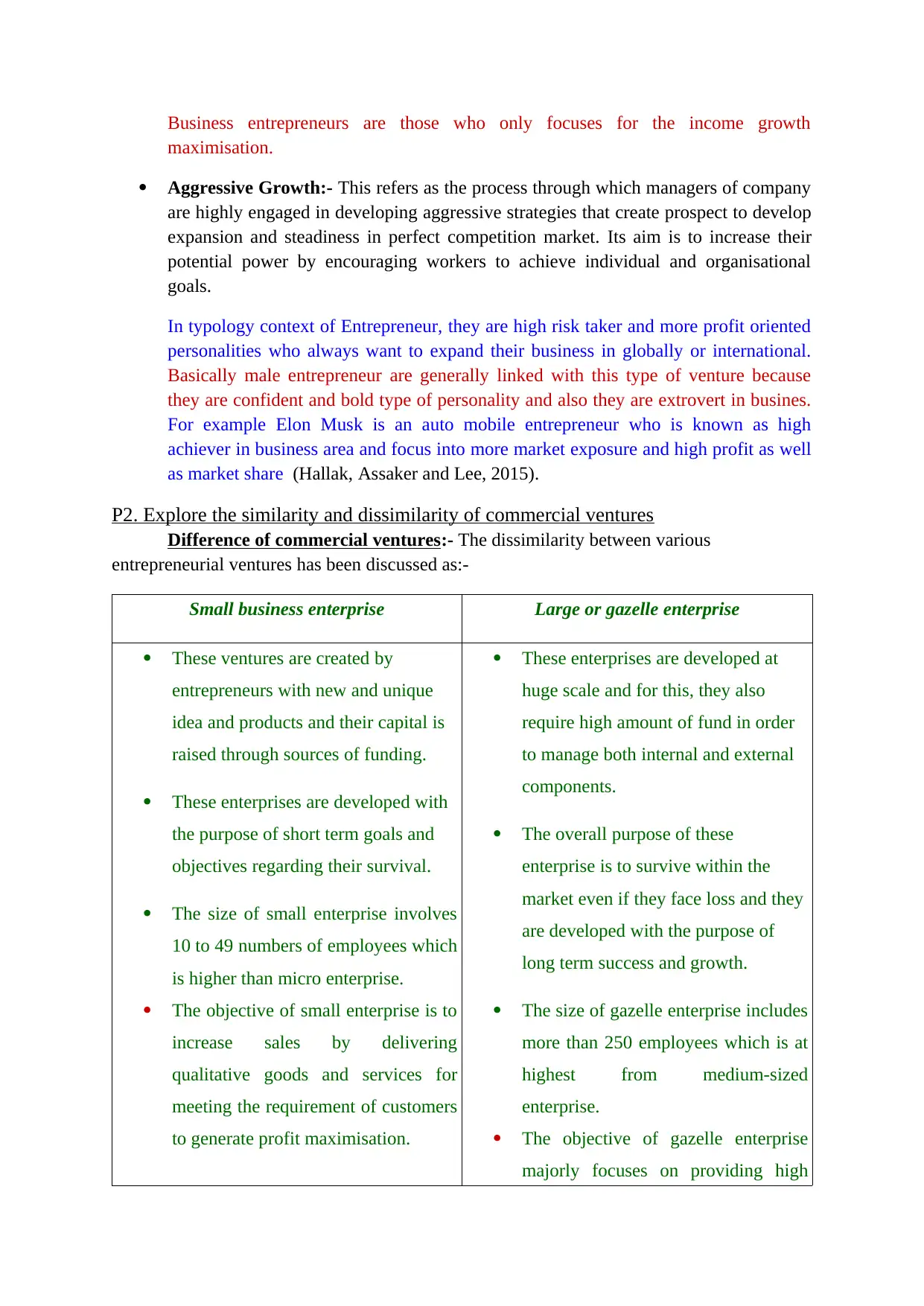
Business entrepreneurs are those who only focuses for the income growth
maximisation.
Aggressive Growth:- This refers as the process through which managers of company
are highly engaged in developing aggressive strategies that create prospect to develop
expansion and steadiness in perfect competition market. Its aim is to increase their
potential power by encouraging workers to achieve individual and organisational
goals.
In typology context of Entrepreneur, they are high risk taker and more profit oriented
personalities who always want to expand their business in globally or international.
Basically male entrepreneur are generally linked with this type of venture because
they are confident and bold type of personality and also they are extrovert in busines.
For example Elon Musk is an auto mobile entrepreneur who is known as high
achiever in business area and focus into more market exposure and high profit as well
as market share (Hallak, Assaker and Lee, 2015).
P2. Explore the similarity and dissimilarity of commercial ventures
Difference of commercial ventures:- The dissimilarity between various
entrepreneurial ventures has been discussed as:-
Small business enterprise Large or gazelle enterprise
These ventures are created by
entrepreneurs with new and unique
idea and products and their capital is
raised through sources of funding.
These enterprises are developed with
the purpose of short term goals and
objectives regarding their survival.
The size of small enterprise involves
10 to 49 numbers of employees which
is higher than micro enterprise.
The objective of small enterprise is to
increase sales by delivering
qualitative goods and services for
meeting the requirement of customers
to generate profit maximisation.
These enterprises are developed at
huge scale and for this, they also
require high amount of fund in order
to manage both internal and external
components.
The overall purpose of these
enterprise is to survive within the
market even if they face loss and they
are developed with the purpose of
long term success and growth.
The size of gazelle enterprise includes
more than 250 employees which is at
highest from medium-sized
enterprise.
The objective of gazelle enterprise
majorly focuses on providing high
maximisation.
Aggressive Growth:- This refers as the process through which managers of company
are highly engaged in developing aggressive strategies that create prospect to develop
expansion and steadiness in perfect competition market. Its aim is to increase their
potential power by encouraging workers to achieve individual and organisational
goals.
In typology context of Entrepreneur, they are high risk taker and more profit oriented
personalities who always want to expand their business in globally or international.
Basically male entrepreneur are generally linked with this type of venture because
they are confident and bold type of personality and also they are extrovert in busines.
For example Elon Musk is an auto mobile entrepreneur who is known as high
achiever in business area and focus into more market exposure and high profit as well
as market share (Hallak, Assaker and Lee, 2015).
P2. Explore the similarity and dissimilarity of commercial ventures
Difference of commercial ventures:- The dissimilarity between various
entrepreneurial ventures has been discussed as:-
Small business enterprise Large or gazelle enterprise
These ventures are created by
entrepreneurs with new and unique
idea and products and their capital is
raised through sources of funding.
These enterprises are developed with
the purpose of short term goals and
objectives regarding their survival.
The size of small enterprise involves
10 to 49 numbers of employees which
is higher than micro enterprise.
The objective of small enterprise is to
increase sales by delivering
qualitative goods and services for
meeting the requirement of customers
to generate profit maximisation.
These enterprises are developed at
huge scale and for this, they also
require high amount of fund in order
to manage both internal and external
components.
The overall purpose of these
enterprise is to survive within the
market even if they face loss and they
are developed with the purpose of
long term success and growth.
The size of gazelle enterprise includes
more than 250 employees which is at
highest from medium-sized
enterprise.
The objective of gazelle enterprise
majorly focuses on providing high

Small Business is also related with
Intrapreneur typology where
individual having desire to presumes
the business with high effectiveness.
customer satisfaction through their
delivering superior productivity.
The large enterprise is also can relate
with Intrapreneur as person are
having desire to optimise the own
type of business venture to establish
as they large enterprise having good
amount of resources availability. So,
they presumes the venture in large
scale.
Social enterprise Micro enterprise
These entrepreneurs came in market
in order to do welfare of people and
society regarding their overall
development.
These ventures also undertake NGOs,
trust and so on.
The main purpose of social enterprise
aims to job creation as they have
ethical values and profits for
investing it again in social objectives.
The size of social enterprise consist
25% employees as full-time workers
and 65% at part-time workers.
They are more influence towards
development in society infrastructure
and procure affordable products to the
people.
These ventures develop with the
purpose of give better future to world
with their prominent vision in order to
develop something new and
innovative which is beneficial for the
community.
The size of micro enterprise includes
fewer than 10 employees that are
owners, managers, leaders and
workers.
The main purpose of micro enterprise
is to spread trade of industries at rural
and urban areas for increasing
economic growth.
A Micro enterprise is also determines
for manufacturing affordable products
as per their customer purchasing
power.
Similarity of entrepreneurial ventures:- There are various similarities between
these five types of entrepreneurial ventures that are most importantly analysed by
entrepreneurs to attain success. It is essential for an organisation to improve its stability at
international marketplace by generating more of its competitive strategies to compete with
rivalries. Some of its similarities are explained as under:-
Intrapreneur typology where
individual having desire to presumes
the business with high effectiveness.
customer satisfaction through their
delivering superior productivity.
The large enterprise is also can relate
with Intrapreneur as person are
having desire to optimise the own
type of business venture to establish
as they large enterprise having good
amount of resources availability. So,
they presumes the venture in large
scale.
Social enterprise Micro enterprise
These entrepreneurs came in market
in order to do welfare of people and
society regarding their overall
development.
These ventures also undertake NGOs,
trust and so on.
The main purpose of social enterprise
aims to job creation as they have
ethical values and profits for
investing it again in social objectives.
The size of social enterprise consist
25% employees as full-time workers
and 65% at part-time workers.
They are more influence towards
development in society infrastructure
and procure affordable products to the
people.
These ventures develop with the
purpose of give better future to world
with their prominent vision in order to
develop something new and
innovative which is beneficial for the
community.
The size of micro enterprise includes
fewer than 10 employees that are
owners, managers, leaders and
workers.
The main purpose of micro enterprise
is to spread trade of industries at rural
and urban areas for increasing
economic growth.
A Micro enterprise is also determines
for manufacturing affordable products
as per their customer purchasing
power.
Similarity of entrepreneurial ventures:- There are various similarities between
these five types of entrepreneurial ventures that are most importantly analysed by
entrepreneurs to attain success. It is essential for an organisation to improve its stability at
international marketplace by generating more of its competitive strategies to compete with
rivalries. Some of its similarities are explained as under:-
⊘ This is a preview!⊘
Do you want full access?
Subscribe today to unlock all pages.

Trusted by 1+ million students worldwide

Able to use scarce resources:- The managers of an enterprise aims to utilise limited
sources effectively for gaining profits that results in building competitive strategies to
challenge oppositions (Jones and Sakong, 2020). It is most important for organisation
to develop good employee relations that result in goal accomplishment at particular
duration.
Maximisation of profits:- The main aim of entrepreneurs is to generate maximise
profits by enlarging customers with qualitative products at least-cost effective pricing
strategy. This results in attaining high profits by encouraging customers to purchase
products at low cost for attaining high level of satisfaction.
Enhance the employment: This is major major objective of owner or manager to
generates employment and recruit potential workforce where they seeking for skilled
and knowledgable people who can contribute their efforts and generates more
outcomes.
Common Objective: Among these entrepreneurship they are looking for common
goal as they have to accomplish profits but also they are looking for more market
share and long term sustainability with attain the better goodwill in competitive
market. Growth in the competitive business environment: the entrepreneurship ventures are
having similarities where as
Private Entrepreneurship are focuses towards the customer requirement and fulfil it.
They are considered to be more risk taker.
Similar in Public entrepreneurship that they are also risk taker and focuses to the
development of innovative and creative ideas for business perspective.
Social Entrepreneurship is also considered for the more creativity and development
towards the society.
M1.
There are various ranges of entrepreneurial ventures with public and corporate sectors
that are as follows:-
Distinctive categories of entrepreneurial ventures:-
Basis Public Sector Private Sector Voluntary Sector
Definition It is described as the
sector which is
totally governed by
policies and
procedures of
government.
The privately owned
sector which does
not allow
government
involvement.
It refers as an
organisation which is
independent and non-
governmental as well
as non-profit
corporation.
Scope The scope of public
sector is to develop
The scope of private
sector is to maximise
The scope of
Voluntary sector is to
sources effectively for gaining profits that results in building competitive strategies to
challenge oppositions (Jones and Sakong, 2020). It is most important for organisation
to develop good employee relations that result in goal accomplishment at particular
duration.
Maximisation of profits:- The main aim of entrepreneurs is to generate maximise
profits by enlarging customers with qualitative products at least-cost effective pricing
strategy. This results in attaining high profits by encouraging customers to purchase
products at low cost for attaining high level of satisfaction.
Enhance the employment: This is major major objective of owner or manager to
generates employment and recruit potential workforce where they seeking for skilled
and knowledgable people who can contribute their efforts and generates more
outcomes.
Common Objective: Among these entrepreneurship they are looking for common
goal as they have to accomplish profits but also they are looking for more market
share and long term sustainability with attain the better goodwill in competitive
market. Growth in the competitive business environment: the entrepreneurship ventures are
having similarities where as
Private Entrepreneurship are focuses towards the customer requirement and fulfil it.
They are considered to be more risk taker.
Similar in Public entrepreneurship that they are also risk taker and focuses to the
development of innovative and creative ideas for business perspective.
Social Entrepreneurship is also considered for the more creativity and development
towards the society.
M1.
There are various ranges of entrepreneurial ventures with public and corporate sectors
that are as follows:-
Distinctive categories of entrepreneurial ventures:-
Basis Public Sector Private Sector Voluntary Sector
Definition It is described as the
sector which is
totally governed by
policies and
procedures of
government.
The privately owned
sector which does
not allow
government
involvement.
It refers as an
organisation which is
independent and non-
governmental as well
as non-profit
corporation.
Scope The scope of public
sector is to develop
The scope of private
sector is to maximise
The scope of
Voluntary sector is to
Paraphrase This Document
Need a fresh take? Get an instant paraphrase of this document with our AI Paraphraser

benefits for social
and economic
growth.
profits by enlarging
customers for
delivering
qualitative products.
maximise social
welfare for providing
facilities to poor
people (Julien and
eds., 2018).
Development Its main objective is
to generate good
atmosphere within
business for
developing relations
among workforce
that leads to
collaborate with
each other for
attaining goals.
The main purpose of
private sector is to
generate guidance
and improvement in
workers by
increasing their
skills to complete
task with efficacy.
The main objective
of Voluntary sector is
to provides charity
and donations for
welfare of society as
they have high value
and profits.
Growth The public sector
majorly focuses on
community interests.
It attains growth by
meeting the
requirements of
customers.
This achieves growth
by gaining customer
support and loyalty.
Related to typology It relates with large
enterprise as they
does not have much
competition and
offer beneficial
services to people.
The private sector
related with small
and micro as they
leads to develop
employment
opportunities of
nation and helps in
developing
economy.
The voluntary sector
related with the
social ventures as
these organisations
conduct social
welfare activities for
people and make
their survival better.
D1.
The difference of commercial ventures on the basis of size, scope, growth and
development are mentioned as below:-
Public sector:- This mainly aims to analyse risk and aims to develop corrective
measure for minimising it to sustain in global market (Karanja, Mwangi and
Nyakarimi, 2014).
Private sector:- Its size is very high with maximisation of capital that generates high
return in future period.
Voluntary sector:- The overall purpose of these organisations is to offer value living
and basic services to people and it is done with the help of trust, charity and so on.
and economic
growth.
profits by enlarging
customers for
delivering
qualitative products.
maximise social
welfare for providing
facilities to poor
people (Julien and
eds., 2018).
Development Its main objective is
to generate good
atmosphere within
business for
developing relations
among workforce
that leads to
collaborate with
each other for
attaining goals.
The main purpose of
private sector is to
generate guidance
and improvement in
workers by
increasing their
skills to complete
task with efficacy.
The main objective
of Voluntary sector is
to provides charity
and donations for
welfare of society as
they have high value
and profits.
Growth The public sector
majorly focuses on
community interests.
It attains growth by
meeting the
requirements of
customers.
This achieves growth
by gaining customer
support and loyalty.
Related to typology It relates with large
enterprise as they
does not have much
competition and
offer beneficial
services to people.
The private sector
related with small
and micro as they
leads to develop
employment
opportunities of
nation and helps in
developing
economy.
The voluntary sector
related with the
social ventures as
these organisations
conduct social
welfare activities for
people and make
their survival better.
D1.
The difference of commercial ventures on the basis of size, scope, growth and
development are mentioned as below:-
Public sector:- This mainly aims to analyse risk and aims to develop corrective
measure for minimising it to sustain in global market (Karanja, Mwangi and
Nyakarimi, 2014).
Private sector:- Its size is very high with maximisation of capital that generates high
return in future period.
Voluntary sector:- The overall purpose of these organisations is to offer value living
and basic services to people and it is done with the help of trust, charity and so on.
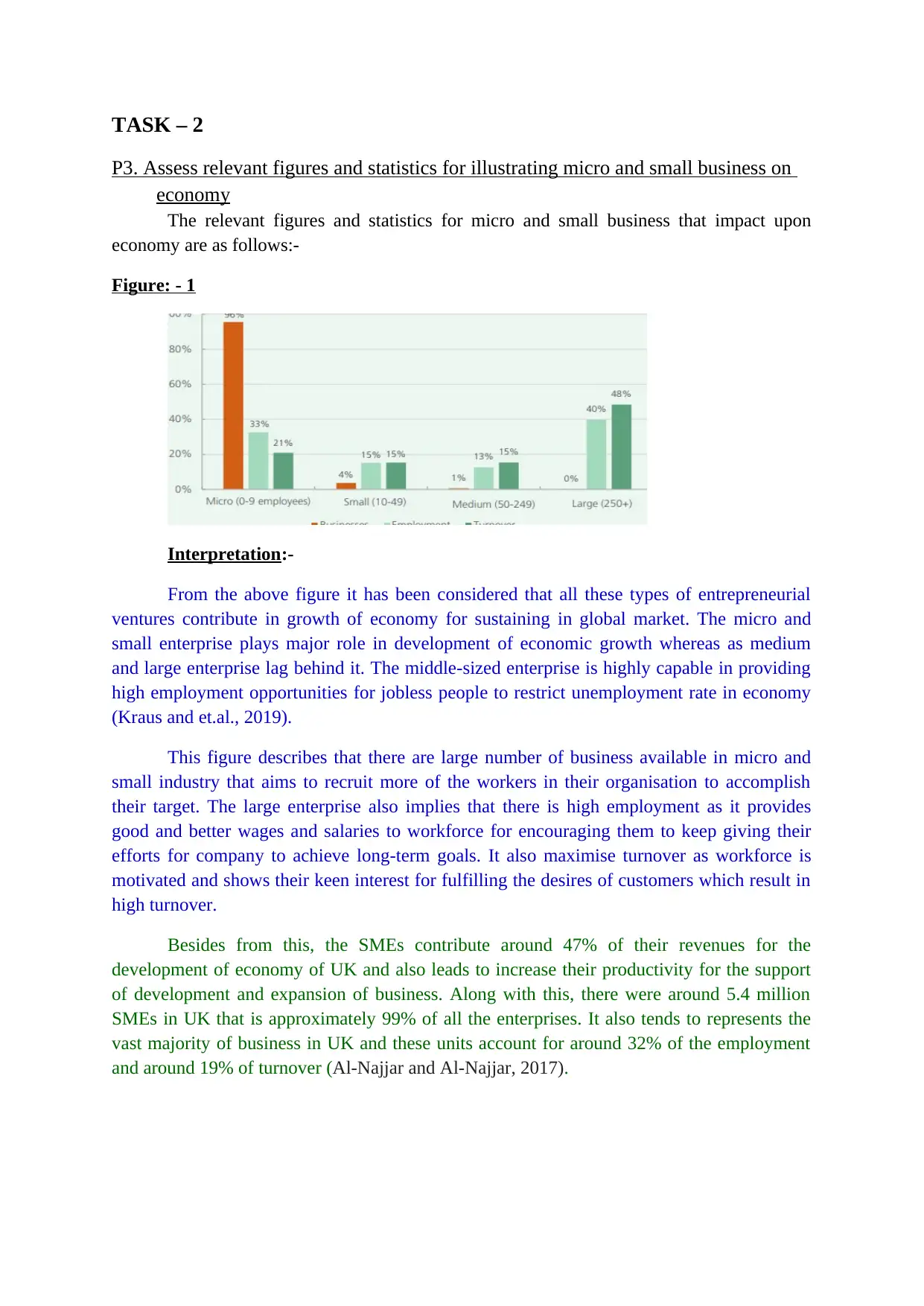
TASK – 2
P3. Assess relevant figures and statistics for illustrating micro and small business on
economy
The relevant figures and statistics for micro and small business that impact upon
economy are as follows:-
Figure: - 1
Interpretation:-
From the above figure it has been considered that all these types of entrepreneurial
ventures contribute in growth of economy for sustaining in global market. The micro and
small enterprise plays major role in development of economic growth whereas as medium
and large enterprise lag behind it. The middle-sized enterprise is highly capable in providing
high employment opportunities for jobless people to restrict unemployment rate in economy
(Kraus and et.al., 2019).
This figure describes that there are large number of business available in micro and
small industry that aims to recruit more of the workers in their organisation to accomplish
their target. The large enterprise also implies that there is high employment as it provides
good and better wages and salaries to workforce for encouraging them to keep giving their
efforts for company to achieve long-term goals. It also maximise turnover as workforce is
motivated and shows their keen interest for fulfilling the desires of customers which result in
high turnover.
Besides from this, the SMEs contribute around 47% of their revenues for the
development of economy of UK and also leads to increase their productivity for the support
of development and expansion of business. Along with this, there were around 5.4 million
SMEs in UK that is approximately 99% of all the enterprises. It also tends to represents the
vast majority of business in UK and these units account for around 32% of the employment
and around 19% of turnover (Al-Najjar and Al-Najjar, 2017).
P3. Assess relevant figures and statistics for illustrating micro and small business on
economy
The relevant figures and statistics for micro and small business that impact upon
economy are as follows:-
Figure: - 1
Interpretation:-
From the above figure it has been considered that all these types of entrepreneurial
ventures contribute in growth of economy for sustaining in global market. The micro and
small enterprise plays major role in development of economic growth whereas as medium
and large enterprise lag behind it. The middle-sized enterprise is highly capable in providing
high employment opportunities for jobless people to restrict unemployment rate in economy
(Kraus and et.al., 2019).
This figure describes that there are large number of business available in micro and
small industry that aims to recruit more of the workers in their organisation to accomplish
their target. The large enterprise also implies that there is high employment as it provides
good and better wages and salaries to workforce for encouraging them to keep giving their
efforts for company to achieve long-term goals. It also maximise turnover as workforce is
motivated and shows their keen interest for fulfilling the desires of customers which result in
high turnover.
Besides from this, the SMEs contribute around 47% of their revenues for the
development of economy of UK and also leads to increase their productivity for the support
of development and expansion of business. Along with this, there were around 5.4 million
SMEs in UK that is approximately 99% of all the enterprises. It also tends to represents the
vast majority of business in UK and these units account for around 32% of the employment
and around 19% of turnover (Al-Najjar and Al-Najjar, 2017).
⊘ This is a preview!⊘
Do you want full access?
Subscribe today to unlock all pages.

Trusted by 1+ million students worldwide
1 out of 22
Related Documents
Your All-in-One AI-Powered Toolkit for Academic Success.
+13062052269
info@desklib.com
Available 24*7 on WhatsApp / Email
![[object Object]](/_next/static/media/star-bottom.7253800d.svg)
Unlock your academic potential
Copyright © 2020–2025 A2Z Services. All Rights Reserved. Developed and managed by ZUCOL.




